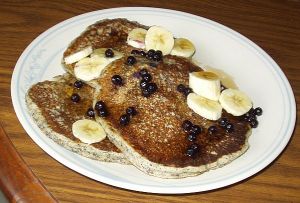 Last year was our first experience growing buckwheat. I’d read that it was a good choice to grow after garlic, so we had a nice stand of it flowering last summer. But, harvesting was time intensive. I went out and hand-picked, yes, hand-picked much of it because a lot of it was not ready when we had an early frost scare. Then the frost wasn’t so bad, and much of the stand went on to keep ripening. I intend not to hand-pick this year, but we’ll see what the weather holds. For the pancakes, I used a regular buttermilk recipe (Betty Crocker cookbook) and substituted half the amount of flour with ground buckwheat. And, the fun part was that I hand milled the buckwheat myself. The Christmas before last, I treated our household to the Family Grain Mill after looking for one that was within budget, easy to use, and could handle harder seeds. So far, this one has been a pleasure to use. I put the buckwheat through twice, adjusting the setting from coarse to fine.
Last year was our first experience growing buckwheat. I’d read that it was a good choice to grow after garlic, so we had a nice stand of it flowering last summer. But, harvesting was time intensive. I went out and hand-picked, yes, hand-picked much of it because a lot of it was not ready when we had an early frost scare. Then the frost wasn’t so bad, and much of the stand went on to keep ripening. I intend not to hand-pick this year, but we’ll see what the weather holds. For the pancakes, I used a regular buttermilk recipe (Betty Crocker cookbook) and substituted half the amount of flour with ground buckwheat. And, the fun part was that I hand milled the buckwheat myself. The Christmas before last, I treated our household to the Family Grain Mill after looking for one that was within budget, easy to use, and could handle harder seeds. So far, this one has been a pleasure to use. I put the buckwheat through twice, adjusting the setting from coarse to fine.
I wasn’t acquainted with the taste of buckwheat in the past, and wasn’t sure if I’d like it in pancakes. But, we both really liked these especially with blueberries and banana. We’ll be making them again, but I’ll probably use store-bought buckwheat to reserve more of the Mancan seeds to sow in the yard. We’ve started our plotting for the next season, and we want to expand the buckwheat growing areas beyond where we planted this year’s garlic. This will mean creative landscaping with pockets of buckwheat and amaranth in among the front yard perennials.

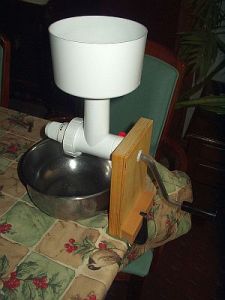
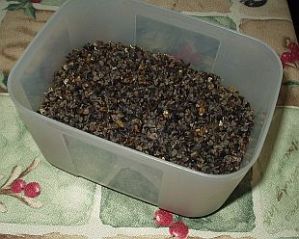
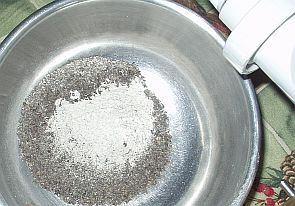
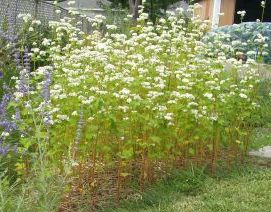
You are supposed to de-hull the buckwheat before grind it for flour. The inside whitish meat is the buckwheat groat, which is what you would purchase from your whole food store, to grind into flour.
That’s interesting. A Wikipedia article on Buckwheat says “The starchy endosperm is white and makes up most or all of buckwheat flour. The seed coat is green or tan, which darkens buckwheat flour. The hull is dark brown or black, and some may be included in buckwheat flour as dark specks. The dark flour is known as blé noir (black wheat) in French, along with the name sarrasin (saracen).” My grandpa’s buckwheat pancakes were darker than those I’ve made with co-op buckwheat groats. When I made pancakes from our ground buckwheat (hull and all), I always used half and half with regular flour. I lived to tell about it, and probably got an excellent dose of fiber. However, I learned that buckwheat is very high in oxalate (as it is in the plant family of rhubarb), which isn’t good for kidney stones, even though it is high in magnesium which helps prevent kidney stones. Until I know more, unfortunately, we will most likely be eating much less of our “black wheat.” So, I would say it’s not necessary to de-hull, but can be left to personal preference.